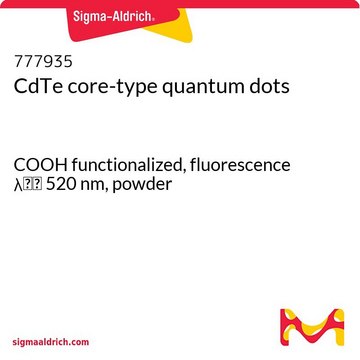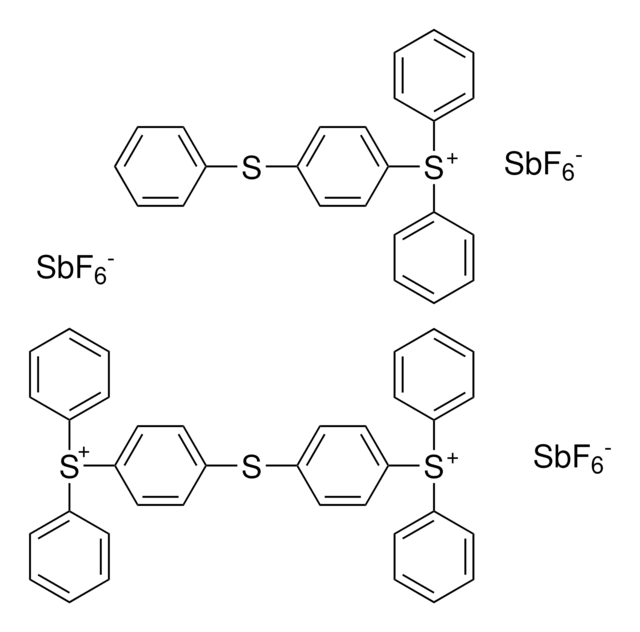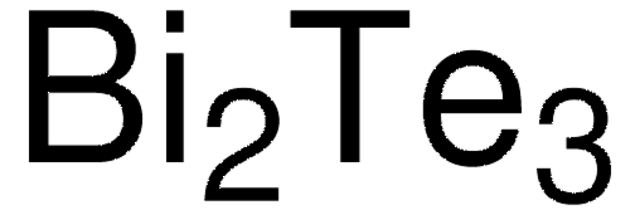256544
Cadmium telluride
powder, <250 μm, deposition grade, ≥99.98% trace metals basis
Sign Into View Organizational & Contract Pricing
All Photos(1)
About This Item
Empirical Formula (Hill Notation):
CdTe
CAS Number:
Molecular Weight:
240.01
EC Number:
MDL number:
UNSPSC Code:
26111700
PubChem Substance ID:
NACRES:
NA.23
Recommended Products
grade
deposition grade
Assay
≥99.98% trace metals basis
form
powder
particle size
<250 μm
bp
1130 °C
mp
1092 °C
density
6.2 g/mL at 25 °C (lit.)
SMILES string
[Cd]=[Te]
InChI
1S/Cd.Te
InChI key
RPPBZEBXAAZZJH-UHFFFAOYSA-N
Looking for similar products? Visit Product Comparison Guide
General description
CdTe is a photonic material. Crystal structure of CdTe is zinc blende structure. 3CdTe is usually an obvious choice for photovoltaic applications because of its; low cost, direct band gap (1.44eV),3 high absorption coefficient, easily doped with p and n type dopants by several preparation techniques. 2
Application
Cadmium telluride may be used in photovoltaic solar cells as the window layer. CdTe was used in the preparation of an Au/Cu2Te/CdTe/CdS/TCO/glass heterostructure for solar cell.
Packaging
Packaged in poly bottles
Signal Word
Warning
Hazard Statements
Precautionary Statements
Hazard Classifications
Acute Tox. 4 Dermal - Acute Tox. 4 Inhalation - Acute Tox. 4 Oral - Aquatic Acute 1 - Aquatic Chronic 1
Storage Class Code
11 - Combustible Solids
WGK
WGK 3
Flash Point(F)
Not applicable
Flash Point(C)
Not applicable
Personal Protective Equipment
dust mask type N95 (US), Eyeshields, Gloves
Choose from one of the most recent versions:
Already Own This Product?
Find documentation for the products that you have recently purchased in the Document Library.
Au/Te/CdTe/CdS/TCO/Glass Solar Cells with Obtained by Sol-Gel as TCO
Marquez Marin J, et al.
International Journal of Photoenergy, 2014 (2014)
Ruizheng Liang et al.
Chemical communications (Cambridge, England), 49(10), 969-971 (2012-12-13)
Ordered ultrathin films based on alternate assembly of CdTe QDs and layered double hydroxide monolayers have been fabricated, which can be used as a photoluminescence temperature sensor with dual-parameter signals and high response sensitivity.
Asad Syed et al.
Spectrochimica acta. Part A, Molecular and biomolecular spectroscopy, 106, 41-47 (2013-01-30)
The growing demand for semiconductor [quantum dots (Q-dots)] nanoparticles has fuelled significant research in developing strategies for their synthesis and characterization. They are extensively investigated by the chemical route; on the other hand, use of microbial sources for biosynthesis witnessed
Juan P Monrás et al.
PloS one, 7(11), e48657-e48657 (2012-11-28)
The vast application of fluorescent semiconductor nanoparticles (NPs) or quantum dots (QDs) has prompted the development of new, cheap and safer methods that allow generating QDs with improved biocompatibility. In this context, green or biological QDs production represents a still
Chong Hyun Chang et al.
Nanoscale, 5(4), 1616-1623 (2013-01-22)
A facile electrodeposition technique was utilized to deposit single-walled carbon nanotubes (SWNTs) with cadmium telluride (CdTe) with well-controlled size, density, surface morphology, and composition. By controlling the applied charge, the morphology of these hybrid nanostructures was altered from CdTe nanoparticles
Our team of scientists has experience in all areas of research including Life Science, Material Science, Chemical Synthesis, Chromatography, Analytical and many others.
Contact Technical Service










